|
October 5, 2006
Hello
from Nova Scotia: The Lighthouse Trail from Shelburne to Lunenburg
This morning
I had left Yarmouth, and after a minor
accident with my rental vehicle, I had explored the Lighthouse
Trail and made a stop in the historic Loyalist town of Shelburne.
By about 4 pm I still had quite a drive left to Lunenburg,
and I wanted to make sure I would get into town before 6:30 so I
would still have some daylight left for my first impressions of
this UNESCO World Heritage Site.
From Shelburne
I went straight east on Highway 103. Had I had more time I would
have explored the coastal peninsula south of Shelburne which features
small villages such as Sandy Point, Jordan Bay and Jordan Ferry.
On the other side of Jordan Bay, a long inlet, I continued past
East Jordon on to Sable River. Lockeport, a small village on the
waterfront, dates back to the 1760s.
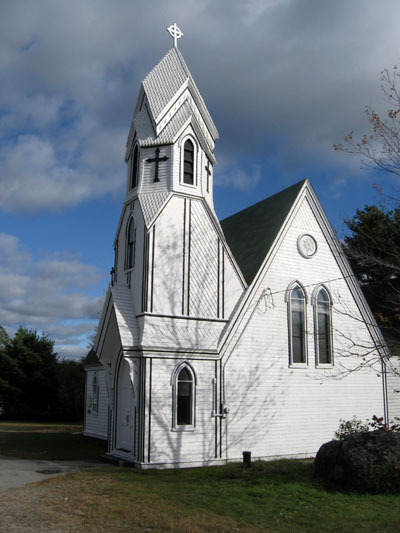
Beautiful country churches line the Lighthouse Trail
The Seaside
Adjunct of the Kejimkujik National Park used to provide pasture
land for sheep and cattle. Some families actually lived on the land
all year while others brought their cattle to summer pasture here.
Overgrown rock foundations, old clearings, broken fences and cattle
trails remain from that era.
The Kejimkujik
Scenic Drive a little further east is a major connector between
Liverpool and Annaopolis Royal on Novascotia’s northwestern
shore and features a drive right through Kejimkujik Park.
Port Mouton,
a little town located inlands just off Summerville Beach is actually
named after a sheep that fell overboard in 1604 from Samuel de Champlain’s
ship. This entire area features many scenic islands and beaches.
The town of Summerville was founded in 1784 by Captain John Grant,
a United Empire Loyalist, and was one of the major shipbuilding
centres in the area. Just south of Summerville Centre on the coast
is Summerville Beach Provincial Park whose highlights include a
white sand beach with sand dunes. The park is wheelchair accessible
and features picnic areas, washrooms and changerooms.
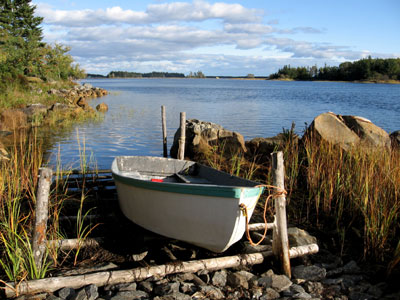
Nova Scotia coastline
Liverpool further
east was founded in 1759 and is steeped in history. It was a centre
of the privateering area between 1749 and 1812, when privateers
(licensed pirates) were permitted to seize enemy ships and valuable
cargo. Liverpool features seven museums including the Sherman Hines
Museum of Photography, the largest museum of its kind east of Montreal.
Medway Harbour
is punctuated by a number of interesting attractions: the Port Medway
Lighthouse Park features interpretive panels that depict the rich
maritime history of this area. The lighthouse was built in 1899
and was decommissioned in 1987. Some of the other lighthouses along
this stretch of shoreline include Coffin Island, Medway Head, Spectacle
Island and Western Head.
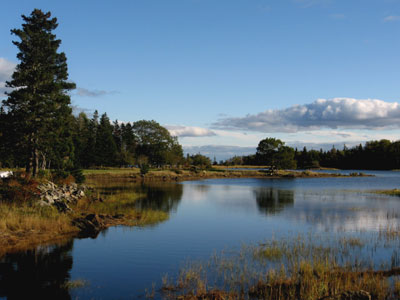
Stunning scenery
Several major
beaches can be found along this southern stretch of Nova Scotia:
from Summerville Beach and White Point Beach west of Liverpool,
to Rissers Beach and Crescent Beach, located close to the mouth
of the La Have River. This beach is the most famous one in the area
and even used to be featured on the Can$50 bill. Crescent Beach
also features the Lost at Sea Quilt, designed by renowned Canadian
fabric artist Laurie Swim. It pays tribute to seventeen fishermen
who lost their lives in one storm, which left a devastating impact
on this community. One example that fishing is one of the most dangerous
occupations on the planet.
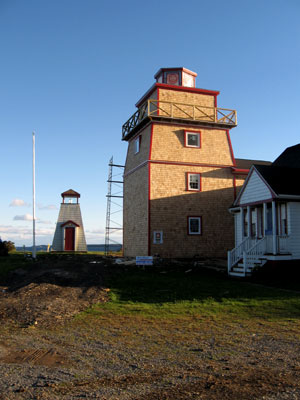
The LaHave River Lighthouse
I then stopped
off at the La Have River Lighthouse which was actually relocated
to this location from another place. And then five minutes later
I got ready to cross the La Have River on the car ferry so I would
not have to drive all the way up to Upper La Have and come down
again on the east side of the river. It took about five minutes
as well as $5 to cross the river. Lunenburg was not far any more
and I was on the home stretch now.
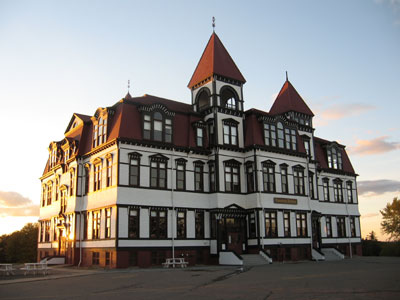
Finally, just
as it was getting dark, I arrived in Lunenburg. I came over the
top of a hill and saw the town spread out in front of me. Several
main streets run east and west parallel to the shoreline with a
few fairly steep north-south streets providing connectors. To get
the lay of the land, I drove through all the major streets and got
a good orientation of this unique town, which was designated a UNESCO
World Heritage Site for being the best example of a planned British
colonial settlement in North America.

St. John's Anglican church
Lunenburg was
officially established in 1753 as the First British Colonial settlement
in Nova Scotia outside Halifax. The original inhabitants of Lunenburg
were “Foreign Protestants”, immigrants from Germany,
Swiss and France which came to North America at the same time as
Pennsylvania Dutch. The economy was mainly based on farming, fishing,
ship-building and ocean-based commerce. Many of the descendents
of these original settlers still live in town.
Today’s
main industry is tourism and I could see a wide range of restaurants,
B&Bs and inns ready to serve tourists in need. On the highest
elevation of town, on Gallow's Hill, I saw a stunning building:
the Lunenburg Academy, still an elementary school, teaching children
from grade 1 to 5. In town, and one of the squares in town features
St. John's Anglican Church, Lunenburg's most famous church.
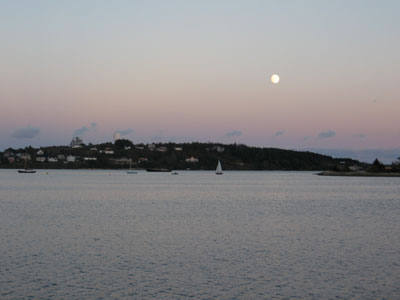
After a very
brief introduction to the town I finally checked into my abode for
the night: the Lunenburg Inn where
I was welcome by owner Don Wallace. Since I had had nothing to eat
since breakfast this morning at the MacKinnon-Cann Inn in Yarmouth,
my stomach was absolutely growling, and I was extremely exhausted.
It had been a very long day and I was ready for a nice relaxing
dinner. Thankfully, the Lunenburg Inn had provided a basket of home-made
cookies for the guest, a sweet treat I could not resist.

Don was so kind
as to give me a few dining suggestions in town and provided me with
a few menus from various local establishments. I decided to head
down to the Rumrunner
Inn right along the waterfront and left my car in the parking
lot. About five minutes later I had arrived at my destination and
settled in for a satisfying meal. After a delicious house salad
I continued with absolutely scrumptious Linguine A La Gorgonzola
which satisfied my overwhelming craving for carbs. But Nova Scotia
is obviously the domain of the seafood eaters and all the restaurants
in this area feature extensive seafood menus. The Rumrunner Inn,
for example, offers a Lobster Bisque Napoleon, a Lobster Dinner
with rice and fresh vegetables, Surf and Turf including a sirloin
steak and a Lobster Thermidor, featuring chunks of lobster in a
creamy sauce with mushrooms and a touch of cognac. Nova Scotia is
a paradise for seafood lovers, and many travellers buy entire boxes
of Nova Scotia lobster during their vacations.
. 
After a very
satisfying meal I dragged my tired body back to my cozy room the
Lunenburg Inn, downloaded my photos and dropped into the comfortable
bed like a bag of potatoes. It had been a really eventful day and
tomorrow I would get a better chance to get to know this scenic
town of Lunenburg before heading over
to Halifax via Peggy’s Cove.
Useful
books about travel to Nova Scotia:
Related
articles:
My five whirlwind days in Nova Scotia
Acadian
history at the Grand Pré National Historic Site
400 years of history at Annapolis
Royal
Port-Royal, a French habitation from 1605
Dinner at the Garrison House
in Annapolis Royal
The Annapolis Royal
Graveyard Tour
The Garrison House Bed and Breakfast
Exploring the Evangeline Trail from
Annapolis Royal to Yarmouth
Learning about Mi'kmaq heritage at the
Bear River First Nation Heritage and Cultural Center
Victorian heritage in Yarmouth
The MacKinnon-Cann Inn: Where Home
and Garden Television meets the Travel Channel
Yarmouth explained - the Yarmouth
County Museum
My car is in the ditch in Chebogue
River
The Lighthouse Trail from Yarmouth
to Shelburne
The Lighthouse Trail from Shelburne
to Lunenburg
The Town of Lunenburg - a UNESCO World Heritage
Site
An interview with the owners of the
Lunenburg Inn
The Lighthouse Trail from Lunenburg to
Halifax via Mahone Bay and Peggy's Cove
Arrival in Halifax and a stunning
musical performance - DRUM!
A Halifax city tour, the city's
connection to the Titantic and the 1917 Halifax Explosion
Exploring the Halifax Harbourwalk and
Pier 21 - Canada's immigration museum
A ferry trip to Dartmouth and saying
goodbye to Halifax
An interview with Pier 21 -
Canada's immigration museum
Helpful
links for travel to Nova Scotia:
Tourism
Nova Scotia
Destination
South West Nova Scotia
Halifax Tourism
|